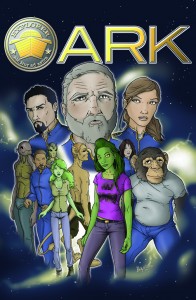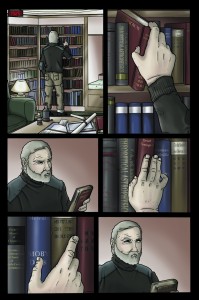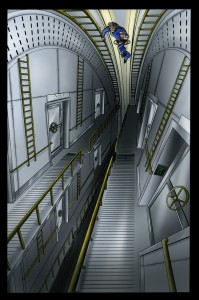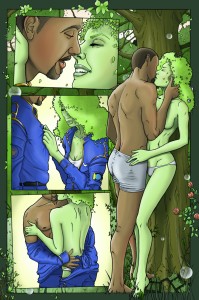“It was just a matter of narrowing down which powers would be useful in space, or just fun to write about” Peter Dabbene creator of the ARK graphic novel talks about meta-humans in space and the perils of publishing
 In the epic sci-fi graphic novel ARK, from writer Peter Dabbene and Arcana Comics a crew of humans and ‘meta-humans’ (human/animal/plant hybrids) discover their fate is not as they thought when a mysterious message from earth reveals the true nature of the mission to their stars is not as they first seemed. But that’s not all, add in some socio-politcal unrest and a good old fashioned ‘whodunnit’ plot and ARK is a brilliant throwback to the world of classic 70s sci-fi like Silent Runnings and Battlestar Galactica. Keen to find out more about the book and the inspirations behind the weird and wonderful creatures on board the ARK we contacted Peter to get the lowdown.
In the epic sci-fi graphic novel ARK, from writer Peter Dabbene and Arcana Comics a crew of humans and ‘meta-humans’ (human/animal/plant hybrids) discover their fate is not as they thought when a mysterious message from earth reveals the true nature of the mission to their stars is not as they first seemed. But that’s not all, add in some socio-politcal unrest and a good old fashioned ‘whodunnit’ plot and ARK is a brilliant throwback to the world of classic 70s sci-fi like Silent Runnings and Battlestar Galactica. Keen to find out more about the book and the inspirations behind the weird and wonderful creatures on board the ARK we contacted Peter to get the lowdown.

Tell us a bit about the inspiration for ARK – it has a very 70s sci-fi feel for me like Silent Running, Soylent Green, or Dark Star, would that be fair and tell us a bit about where the ideas for the characters and the scenario come from?
PD: I’ve seen all of those movies, so they probably did have some residual influence, along with the original Battlestar Galactica TV show. If you recall, there were plenty of non-Cylon episodes on that show, where significant amounts of tension were created just by the fact that these people were kind of… stuck with each other. 🙂
I always liked the quiet, remote, distant feel of those stories — and for me I’d put all the sci-fi stuff we’ve mentioned alongside the classic mystery convention of having characters stuck together in one place, with murders happening — you know, stranded by a snowstorm at an old mansion, that sort of thing.
And then I’d also throw in superhero comics as an influence too — Chris Claremont’s Uncanny X-Men was an example of super-powered characters who you could enjoy, just watching them do normal stuff. And I’ve always had a soft spot for animal-powered superheroes, like the old X-Men villains the Ani-Men, for example, or Animal Man. So that was part of the inspiration for the meta-humans. I read a lot of science magazines; there’s so much weird stuff that plants and animals can do, it was really just a matter of narrowing it down to which powers would be useful in space, or on another planet, or just fun to write about.
Tell us a bit more about the meta humans? Which animals are they based on and how important is it for you to set scientific ground rules to write them to (For example you have them being sterile in the first book)
PD: I didn’t go into great detail about which animals the metas are based on, simply because I wanted to avoid too much exposition, and because it’s kind of fun (I hope) for the reader to try to figure that out. I did give some clues with the names, in some cases — Lee is an eel meta-human, Dick (as in Moby) has sperm-whale attributes, and Iris is flower-based. Some of the others include geckos, fireflies, ants, parrots, and kangaroo rats.
The name of the game in sci-fi is pseudo-science — just a way of saying that if you ground everything in current or very likely to happen near-future technology, then you’re very limited as to what you can do. I like to throw in science stuff when it fits, but I also don’t want to bog the reader down with it too much. For example, I didn’t get into how the ship works in detail in ARK — maybe future volumes will reveal more of that, when it’s appropriate. More will be revealed about the metas, as well.

The isolated setting is great for creating tension but what happens if you want to introduce new characters? Will there be a group of crew members we’ve just not seen yet or do you think the characters you have can fulfil all the plot ideas you have?
PD: I wanted to avoid what I call the Star Trek situation — that is, disposable characters you’ve never seen before, introduced for one episode or storyline and then you never see them again. I get how that works in television, with guest stars and such, but I don’t want it to seem like I’m just creating a character and throwing him or her in on a whim for future stories. So what you see in ARK is pretty much what you get — for now. There are other things I have in mind for the future stories, though, and plenty of characters who have small (or nearly nonexistent) roles in this first volume of ARK will be more important to future storylines. Hopefully that makes it more interesting, as we’ll have different points of view on the same events.
Like all good sci-fi ARK isn’t just about spaceships and aliens there’s plenty of social comment and analysis (racial divides, genetic engineering, even a religious element with the Ark comparisons) how important are those elements to telling a good story in your opinion?
PD: I think it’s very important to have multiple “levels” to a story — on the surface, hopefully a good action-adventure mystery, but one of the reasons science fiction works so well is its ability to lay another level of meaning below the surface. Stories that hit on more than one level are the ones that people tend to read and recommend, and the ones that have some chance of really impacting people, and that’s always my goal.
How did you hook up with artist Ryan Bayliss, what do you think be brings to the book and have you guys worked together before or is ARK your first collaboration?
PD: I hooked up with Ryan after searching the internet for an artist. I’d looked locally (New Jersey, USA) but had no luck, and finally found Ryan’s website. I liked his style, and he studied sequential art, so I knew he knew how to tell a story instead of just drawing pretty pictures. ARK is our first collaboration, but we’re at work on a very expansive sci-fi graphic novel called The Adventures of SpamFram, which we hope to complete in the next year. Ryan and I work very well together, and even though he’s in the UK and we work via e-mail, I think we have a pretty good rapport, and we’re both happy with the results of the partnership.

You’re releasing the book digitally after facing some problems getting it out there in print. Tell us a bit about your experiences of getting ARK published?
PD: Well, ARK is being issued in print, but it is definitely a struggle to get printed books out there. People can order it from Amazon, or directly from Arcana, but apparently Diamond Previews decided they weren’t going to list all of Arcana‘s titles anymore, and that’s the main way to get your book in comic stores. So we’re doing what we can as far as the print version, but the digital version is available and ready to be downloaded from ComiXology at any time.
Arcana has been very supportive, but like all publishers, they’re trying to figure out where the industry is going, in terms of digital vs. print. The distribution problem is a big one, but Arcana‘s selling ARK directly to comic stores and dealers at a significant discount, so hopefully some stores will stock the book that way.
Do you see digital as the saviour for smaller-scale books like ARK or does it still have its downsides?
PD: Digital is definitely another tool in the arsenal, but I wouldn’t say it’s a savior, exactly. The lower barriers to entry in terms of cost is definitely a good thing. But there are a lot of people who still go into a comic store or bookstore and just browse before deciding what to buy. So you don’t want to miss those people. I think there needs to be more of a physical presence for digital books, maybe something along the lines of what Barnes and Noble does with the Nook — you go in the store, see a poster or a sample copy that catches your eye, and download the book to your iPad right there, with the comic store getting a cut.
The lowered costs for digital also means a lot more competition in the marketplace. One of the reasons I was happy to work with Arcana is that they’ve got a good reputation for putting out quality stuff, and I think with so much material available out there, a lot of readers will buy with more confidence seeing the Arcana name, rather than some unknown start-up label.

What are your hopes for ARK in the long term, how long will it run for and do you have an end mapped out for it or are just waiting to see how things progress?
PD: Arcana agreed to a three book series of graphic novels for ARK, so I certainly hope to see that through, but of course it all depends on sales, and whether it’s financially viable for me to do that. I mean, I think I’d want to tell those stories at some point no matter what, but it’s a question of whether that happens inside five years, or fifteen, or more.
I have a lot of ideas for the sequels, and I could easily extend the series beyond three books if the demand was there. But I don’t want to do an open-ended ongoing series where the funding gives out and the story never gets completed — I like an ending when I read a story, so I want to give that to the reader in each volume, even if it leaves an opening for the next story.
As for greater hopes, my ideal would be to see ARK picked up as a TV series — I think it would be really great, and it drives me crazy when I see some of the dreck that SyFy Channel and other similarly themed networks put out there. Of course, the chances are very much against that happening, but it’d be nice if it did.
The ARK is available digitally on ComiXology as well as from Amazon or direct from Arcana. For more information visit the ARK Facebook page



Pipedream Comics | The official Website of Peter Dabbene
April 5, 2014 @ 11:02 pm
[…] Pipedream Comics — “Peter Dabbene, creator of the ARK graphic novel, talks about meta-humans in space and the perils of publishing”: http://pipedreamcomics.co.uk/peter-dabbene-creator-of-the-ark-graphic-novel/ […]
December 20, 2025 @ 11:26 am
Engagieren Sie sich jeden Tag, um Ihre Gewinnchancen zu maximieren–je mehr Sie spielen, desto mehr Tickets und Einsendungen sammeln Sie für die wichtigsten Preisereignisse
des Festivals. Um die neueste, sichere Version der Admiral Casino-App zu erhalten, laden Sie
sie aus offiziellen Stores oder von unserer Website herunter.
Wenn Sie die Plattform auf Ihr Mobilgerät herunterladen, haben Sie Hunderte beliebter Titel in der Tasche, die Sie auf dem
Weg zur Arbeit, in der Mittagspause oder beim Entspannen zu
Hause spielen können.
Ein Spiel ohne Abstürze ist eine Garantie dafür, dass in einem entscheidenden Moment die Ergebnisse
nicht einfrieren und Ihr Spielkonto nicht zurückgesetzt wird.
Sie finden denselben großen Katalog an Unterhaltung und Stunden voller Aufregung
und Vergnügen. Das Casino bietet seinen Spielern die
Möglichkeit, Video-Slots für jeden Geschmack
auszuprobieren, was nur positive Emotionen und gute Laune hervorruft.
Spielautomaten im Admiral Casino online sind für viele Spieler eine der beliebtesten Unterhaltungen. Das Portal
bietet hervorragende Kooperationsbedingungen, die sowohl für
Anfänger als auch für erfahrene Spieler geeignet sind.
Wählen Sie Spiele nach Ihren Wünschen und erhalten Sie zusätzliche Belohnungen dafür.
Unsere Elitespieler erhalten außerdem frühzeitigen Zugriff auf neue Spiele und Feature-Releases.
Durch die Qualifikation für unser VIP-Programm erhalten Sie Zugriff auf außergewöhnliche Funktionen, die Gelegenheitsspielern oft nicht
zur Verfügung stehen. Aktivieren Sie Ihren Bonus, indem Sie sich bei Admiral registrieren und Ihre erste Einzahlung tätigen, um
zusätzliche € plus eine Reihe von Freispielen zu erhalten. Unsere Live-Dealer-Lounge
bietet authentische Action mit Echtzeitspielen, die von Profis veranstaltet werden. Unsere Plattform bietet Ihnen die Möglichkeit, in Ihrer lokalen Währung–€ zu spielen.
References:
https://online-spielhallen.de/instant-casino-deutschland-schneller-spielspas-im-fokus/
December 20, 2025 @ 1:00 pm
Viele Nutzer sperren sich selbst, um gefährlichem Spielverhalten entgegenzuwirken.
In Deutschland lizenzierte Online Casinos müssen seither mit dem System von OASIS
arbeiten, wodurch einige Einschränkungen für Spieler entstanden sind.
Unter dem Kürzel OASIS versteht man in der Welt der Glücksspiele seit 2021
den Begriff „Online Abfrage Spielerstatus”. Die OASIS Spielersperre, Einsatzlimits und Wartezeiten gehören zu den Störfaktoren, die
Nutzer im Online Casino beklagen. Wir versuchen, ein möglichst
vielfältiges und einzigartiges Angebot für alle Spieleliebhaber anzubieten. Kann euch dieser nicht weiterhelfen,
solltet ihr euch an die deutsche Lizenzbehörde der
GGL wenden.
Malta gilt als seriöse Regulierungsbehörde, auch wenn es immer noch kein deutsches GGL-Siegel
ist. Slots ohne Ende, Live-Casino mit echten Dealern, sogar ein paar exotische Tischspiele, die ich noch nie gesehen habe.
Die Plattformen selbst sind lizenziert, nur halt nicht in Deutschland.
Rechtmäßig ist es nicht unbedingt illegal – so ein typisch deutsches Dilemma.
Ohne deutsche Limitierungen holen viele Anbieter die Bonuskanone raus und belohnen dich großzügiger.
Während OASIS ausschließlich Sperren verwaltet und Spieler blockiert, überwacht
LUGAS Zahlungsströme, Limits und Aktivitätszeiten in allen Casinos mit deutscher Lizenz.
Selbstsperren gelten mindestens 3 Monate,
während Fremdsperren oft deutlich länger bestehen bleiben. Die beste
Casinos ohne OASIS bieten mehr Zahlungsmethoden, höhere Freiheit bei Limits
und schnellere Auszahlungen. Abseits der Klassiker bieten die
beste Casinos ohne OASIS auch charmante Exoten wie Rubbellose, Bingo,
Keno oder Arcade Games. Maximale Spannung trifft
auf gigantische Potenziale, und das ganz ohne deutsche
Limitierungen.
References:
https://online-spielhallen.de/ihr-zugang-zur-gaming-welt-lucky-dreams-casino-login/
December 21, 2025 @ 3:56 pm
Online Blackjack ist die digitale Version des weltbekannten Kartenspiels.
Denn woher wissen Sie, dass ein Video Slot oder ein bestimmtes
Roulette Spiel seine Zeit (und auch sein Geld) wert ist, wenn Sie es
noch nie zuvor gespielt haben?
Testen Sie auch einmal den Turbo Modus und das Quick Play,
um Ihre liebste Variante für das Spiel im Echtgeld Online Casino
herauszufinden. So wird im Quick Play beispielsweise auf Animationen verzichtet.
Zwei Sondersymbole, ein Wild und ein Scatter, bieten spannende Extrafunktionen.
Denn ohne eine Genehmigung durch mindestens eine anerkannte Glücksspielbehörde, solltet ihr die Webseite sofort wieder verlassen. Selbst wenn ihr bis auf
Weiteres nur Spielgeld im Casino verwenden möchtet, sollte die Nutzung nur bei seriösen Portalen erfolgen. Wer dagegen überwiegend in einem
WLAN spielt, kann auf den Download einer Casino App verzichten und die Demo-Spiele so auf seinem Handy nutzen.
References:
https://online-spielhallen.de/vinyl-casino-bewertung-ein-umfassender-uberblick/
December 26, 2025 @ 12:13 pm
As someone who prefers to play in person,
I’m not ashamed to say that I’ve visited almost every online
casino under the sky in Australia (especially
during my peak poker days). That aside, I completely understand the appeal behind online gambling sites, and when put side-by-side, it even makes more sense to play online.
You shouldn’t settle for Australian online casino sites that need 3 days to approve a payout request.
Wagering requirements must be within industry limits, the bonuses
should be accessible to all players, and the expiry dates should be
reasonable. The three things these games have in common are that their RTP is very high
(usually 98%+), the gameplay is quick, and they all offer
a different type of gameplay. This adds yet another element to
playing casino games, and I’m all in for this one.
As a result, it stands as the most popular payment method at Australia’s fast withdrawal casinos.
Start with basic crash games that focus solely on timing the cashout, before trying variants with added features or side bets.
Crash games put you in the driver’s seat as you
place bets on a rapidly growing multiplier. You can play blackjack, baccarat, roulette, and poker as you watch the action take
place in real time.
This is also where you can win a maximum of 37,500 times your stake if
the correct stars align, making it one of the
best online pokies for real money. We’ve done the heavy lifting to find
Australia’s leading online pokies for real money.
Let’s talk about the best pokies to play for real money,
what makes them better, and the factors that play an important role in fairness and payouts.
Casinojax offers a variety of slots, table games, and live
dealer options to cater to all player preferences.
With its wide range of games, enticing bonuses, and secure platform, it’s a top
destination for both novice and experienced gamers.
A well-designed mobile web version offers
a viable alternative, ensuring that players can still access
their favorite games without compromising on quality
or features.
References:
https://blackcoin.co/casino-club-erfahrungen/
December 26, 2025 @ 1:50 pm
15th-century Italy saw the formation of the two main variants that are
known today. By the ninth century, the Caroline script, which was
very similar to the present-day form, was the principal form
used in book-making, before the advent of the printing press.
There was also a cursive style used for everyday or utilitarian writing, which was done on more perishable
surfaces.
Identify suppliers that are debarred from participating in government procurement.
EGP helps to ensure the provision of equal treatment to all bidders, applying same
rule of law, increase accountability of participants in the procurement process and at
the same time raising awareness on the general public about the expenses
of the government. French-English dictionary, translator, and learning Spanish-English
dictionary, translator, and learning
References:
https://blackcoin.co/best-payid-pokies-in-australia-a-comprehensive-guide/
December 26, 2025 @ 2:23 pm
Whether you’re playing blackjack, roulette, or live game
shows, expect quick access to tables with no noticeable lag.
This mix of entertainment and flexibility is what makes Australian live dealer casinos stand out.
He loves getting into the nitty gritty of how casinos and
sportsbooks really operate in order to make solid…
Players over the age of 18 in Australia can enjoy online
gambling sites so long as it is licensed by the ACMA. For more information about any particular casino, please read our in-depth online casino reviews.
Crash games are a relatively new and exciting addition to
online casinos. Modern pokies in online casinos often include free spins, multipliers,
and progressive jackpots for bigger prizes.
From generous bonuses to thorough game libraries, these
online sites cater to all types of players. There are many online casinos to consider, but here
are our 5 best picks for Australian players.
Even though we promote healthy environments for playing at aussie online casinos, you should know that safe gameplay is largely up to
you to control.
References:
https://blackcoin.co/59_online-casino-vip-programs_rewrite_1/
December 26, 2025 @ 2:56 pm
Each player can take advantage of available tips and strategy
guides, allowing smarter gameplay and bigger rewards.
Play blackjack online for free with Arkadium and see just how good you are at this classic card game.
That’s exactly what you get from our game and it doesn’t cost you a cent to play it!
All in all, mobile gaming at Springbok is one of the best uses of your
smartphone or tablet! Enter the mobile casino – the no waiting platform
par excellence. As well as becoming ever more popular,
mobile gaming allows quick, short gaming sessions.
For crypto players seeking the utmost quality across online casino gaming, live dealer options, and sports betting with a dedication to player value,
FortuneJack emerges as a premier one-stop shop. Its gaming catalog
spanning thousands of top-quality slots, specialty games, and a premium live dealer offering stands unrivaled
in variety and quality. As one of the original Bitcoin-friendly online casinos since 2014, 7Bit Casino continues
providing an enjoyable iGaming destination for crypto enthusiasts and traditional players alike.
Metaspins is a new, feature-rich crypto casino with a solid lineup of
games, generous bonuses, ultra-fast payouts, and
a modern, easy-to-use interface that positions it as a top choice
for online gambling enthusiasts.
For example, live casino games will normally
not be available to play for free, as they require real dealers and lots of
equipment to offer the games. The first is obviously that you cannot
win or lose any real money from playing demo casino games.
When you play casino games for free in demo mode, the
gameplay will normally work exactly the same as
in real money versions.
References:
https://blackcoin.co/luck-nation-casino-real-money-pokies-australia/
December 26, 2025 @ 3:43 pm
It provides secure transactions and multiple payment options,
including credit cards, e-wallets, and cryptocurrencies.
Bizzo’s team prioritises your peace of mind by ensuring a
secure gaming environment through advanced encryption protocols, safeguarding
your personal and financial information. Quality and reliability are a given when you play
at Bizzo. Try them out risk-free with the free-play option. With all
this savvy tech talk, we almost forgot to mention the
game selection on Bizzo Casino Australia. With this convenient alternative to
the desktop and app versions, you can navigate the virtual casino
with even less effort.
Bizzo Casino, a licensed and secure casino, offers fantastic opportunities
for players with all the different needs and
wants. Join this popular online casino brand and see why it is the No.
1 choice for so many Aussie players! The online casino will add your
deposit instantly, and you’ll be ready to play in an instant!
Bizzo Casino takes pride in its vast array of
live games, catering to diverse player preferences.
References:
https://blackcoin.co/speedau-casino-your-gateway-to-real-money-gaming/
December 27, 2025 @ 5:02 am
These offers help you play more without spending too
much. They give players extra money, free spins, or cashback.
Lastly, the evergreen casino Rocket no deposit allows users to join tournaments or challenges with
zero initial investment.
Do you love playing online games and free slots? The Bitcoin casinos included in our article offer a wide range of free spin promotions
that cater to different types of players. Finally, there’s
also a recharge bonus, which allows players to collect rewards on subsequent deposits.
References:
https://blackcoin.co/victor96-your-ultimate-entertainment-destination-1-gaming-hub-in-australia/
December 28, 2025 @ 10:37 pm
online betting with paypal winnersbet
References:
https://arlogjobs.org
December 28, 2025 @ 11:15 pm
online casino mit paypal einzahlung
References:
kikijobs.com
December 29, 2025 @ 7:24 am
online poker real money paypal
References:
firstcanadajobs.ca
December 29, 2025 @ 7:48 am
australian online casinos that accept paypal
References:
https://jobs.assist24-7.com/employer/best-paypal-online-casinos-in-the-us-2025
December 30, 2025 @ 12:44 am
casinos online paypal
References:
metagap.ro
December 30, 2025 @ 1:01 am
casino sites that accept paypal
References:
jobsharmony.com